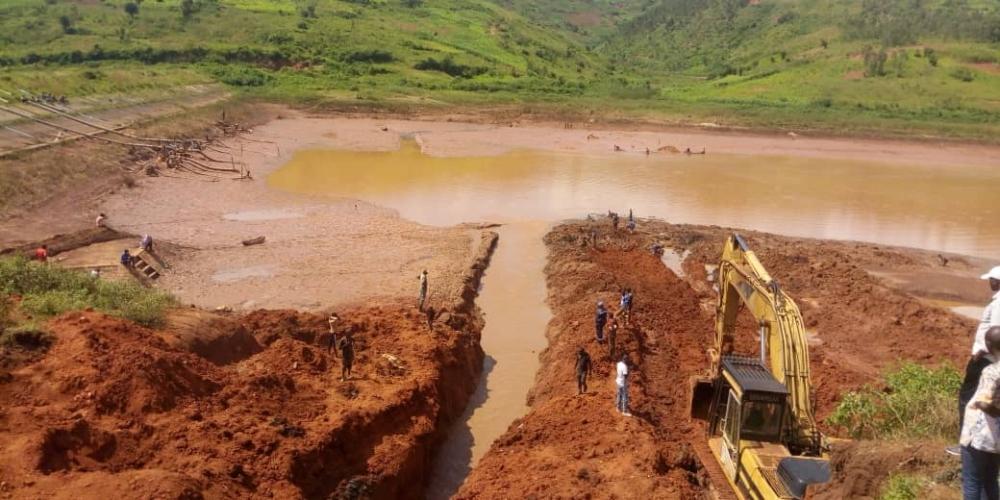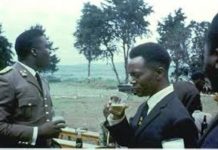Africa-Press – Rwanda. On April 23, 1994, the Genocide against the Tutsi continued across Rwanda, and especially in the former Butare, Gikongoro and Gitarama prefectures.
Tutsi were killed in Kabuye Sector, in the former Ndorwa Commune, Butare Prefecture. Refugees had arrived in Kabuye, in current day Gisagara District, from nearby Nyaruguru, where massacres had already started. Some had taken refuge with relatives, while others stayed at a market place.
Interim president Theodore Sindikubwabo had visited Gisagara sous-prefecture on April 21 to launch the Genocide. Sindikubwabo had incited the Hutu to kill the Tutsi.
The next day, a mechanic identified as Fidele Uwizeye brought a commune car with police and arrested all the youths who had taken refuge there. They were detained at a police station and were eventually killed in the evening in the Rwasave forest.
On April 23, 1994, Gisagara sous-prefect Dominique Ntawukuriryayo Callixte Kalimanzira and mayor of Ndora commune Pierre Rwankubito ordered the Tutsi refugees to go to Kabuye hill.
They then brought soldiers and police to shoot them. The next day, survivors were also killed in an attack led by the Mayor of Muganza commune, Elie Ndayambaje, Burundians from Kibayi camp, and members of a militia group called “Jaguar.”
Among the people implicated in the massacres in Gisagara include interim president Sindikubwabo, sous-prefect Ntawukuriryayo, Rwankubito, businessman Gaëtan Uwihoreye, the head of the MRND party Laurent Singirankabo, and the president of MDR party Vianney Sindikubwabo.
MP Bernadette Mukarurangwa would come to monitor the progress of the Genocide implementation in Ndora Commune.
Dominique Ntawukuriryayo was convicted of genocide crimes by the International Criminal Tribunal for Rwanda and sentenced to 20 years in prison.
Massacre in Gikongoro
On April 9, 1994, Tutsi began to flee to Musange Commune, Gikongoro prefecture in current day Nyamagabe District. On the same day, mayor Bernard Bizimana toured all sectors of Musange commune urging Tutsi to go to the commune office, promising them protection. Many sought refuge at the commune while others went to the court nearby.
In the morning of April 23, Interahamwe militia and soldiers shot at the Tutsi refugees for about half an hour. Then civilians with machetes, wooden clubs with nails, small hoes and other crude weapons killed the surviving ones. The massacre continued until evening as it rained.
During the night, survivors took their way to Nyanza, Butare and many were killed at Nyamagana pond.
Among those involved in the Musange massacre was commune mayor (bourgmestre) Bernard Bizimana, former Kaguha sous-prefect Joachim Hategekimana, director of BNR Dominique Munyangoga, a director at Musange health centre identified as Mugwaneza, an agronomist known as Akimana and former education inspector Rwamuhungi.
Tutsi thrown in Nyamagana pond
Nyamagana pond in Nyanza District had been set up for watering crops during the reign of King Mutara III Rudahigwa, but in 1994, killers turned the site into a place to dump their slain victims.
During the Genocide, many Tutsi from Gikongoro prefecture, especially Rukondo and Kinyamakara communes, fled to Nyanza hoping for protection. Some of the survivors of the Kaduha parish attack also fled to Nyanza.
There was a roadblock at the pond, to which Tutsi were called on the promise of protection. Many of them were killed with guns, machetes, clubs and other crude weapons. Others were thrown into the pond.
Those who tried to swim were stoned until they got tired. One Eraste Mudacumura is known to have been thrown into the water after his killers chased him for long. They later mocked him that he had committed suicide.
Those involved in the Nyamagana killings included gendarmes like Haguma and Captain Francois Xavier Birikunzira who collaborated with an Interahamwe group called “Imberebere.”
Tutsi massacred at Bitsibo school, Kamonyi
The massacre of Tutsi on Bitsibo hill, in Kamonyi District, started on April 20, 1994. Tutsi began to flee for their lives, hiding with their neighbours and in the bush. Others were taken by local leaders to Musambira commune to be killed.
On April 23, 1994, the authorities tricked those who still survived and declared that peace had been restored, leading many still in hiding to return to their homes. Upon return on April 23, they were taken to Bitsibo Primary School, where they were killed in the evening and thrown in an old pit that had been dug during the school’s construction.
The number of victims of the Bitsibo massacre is estimated to be very large because many Tutsi had fled there from Kayenzi commune April 21 and 22 and Gacurabwenge sector. The Tutsi whose lives were taken at the school were killed withtraditional weapons, including machetes and clubs.
Some of the alleged notable perpetrators included Minani, Mbuguje, Augustin Badege, Aloys (the cell leader), and a one Bertin Rutagengwa.
For More News And Analysis About Rwanda Follow Africa-Press






